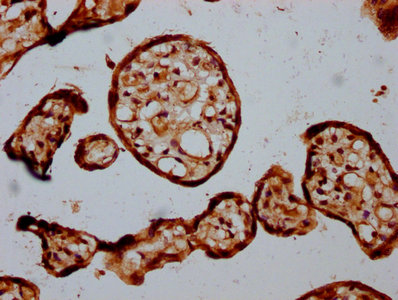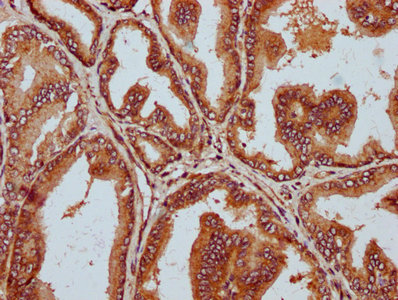
IHC image of CSB-PA823456LA01HU diluted at 1:300 and staining in paraffin-embedded human placenta tissue performed on a Leica BondTM system. After dewaxing and hydration, antigen retrieval was mediated by high pressure in a citrate buffer (pH 6.0). Section was blocked with 10% normal goat serum 30min at RT. Then primary antibody (1% BSA) was incubated at 4°C overnight. The primary is detected by a biotinylated secondary antibody and visualized using an HRP conjugated SP system.
STT3B Antibody
CSB-PA823456LA01HU
ApplicationsELISA, ImmunoHistoChemistry
Product group Antibodies
ReactivityHuman
TargetSTT3B
Overview
- SupplierCusabio
- Product NameSTT3B Antibody
- Delivery Days Customer20
- ApplicationsELISA, ImmunoHistoChemistry
- CertificationResearch Use Only
- ClonalityPolyclonal
- ConjugateUnconjugated
- Gene ID201595
- Target nameSTT3B
- Target descriptionSTT3 oligosaccharyltransferase complex catalytic subunit B
- Target synonymsCDG1X, SIMP, STT3-B, dolichyl-diphosphooligosaccharide--protein glycosyltransferase subunit STT3B, STT3, subunit of the oligosaccharyltransferase complex, homolog B, STT3B, catalytic subunit of the oligosaccharyltransferase complex, STT3B, subunit of the oligosaccharyltransferase complex (catalytic), dolichyl-diphosphooligosaccharide protein glycotransferase, homolog of yeast STT3, oligosaccharyl transferase subunit STT3B, source of immunodominant MHC-associated peptides homolog
- HostRabbit
- IsotypeIgG
- Protein IDQ8TCJ2
- Protein NameDolichyl-diphosphooligosaccharide--protein glycosyltransferase subunit STT3B
- Scientific DescriptionCatalytic subunit of the N-oligosaccharyl transferase (OST) complex which catalyzes the transfer of a high mannose oligosaccharide from a lipid-linked oligosaccharide donor to an asparagine residue within an Asn-X-Ser/Thr consensus motif in nascent polypeptide chains. N-glycosylation occurs cotranslationally and the complex associates with the Sec61 complex at the channel-forming translocon complex that mediates protein translocation across the endoplasmic reticulum (ER). STT3B is present in a small subset of OST complexes and mediates both cotranslational and post-translational N-glycosylation of target proteins: STT3B-containing complexes are required for efficient post-translational glycosylation and while they are less competent than STT3A-containing complexes for cotranslational glycosylation, they have the ability to mediate glycosylation of some nascent sites that are not accessible for STT3A. STT3B-containing complexes also act post-translationally and mediate modification of skipped glycosylation sites in unfolded proteins. Plays a role in ER-associated degradation (ERAD) pathway that mediates ubiquitin-dependent degradation of misfolded endoplasmic reticulum proteins by mediating N-glycosylation of unfolded proteins, which are then recognized by the ERAD pathway and targeted for degradation. Mediates glycosylation of the disease variant AMYL-TTR Asp-38 of TTR at Asn-118, leading to its degradation.
- ReactivityHuman
- Storage Instruction-20°C or -80°C
- UNSPSC41116161



